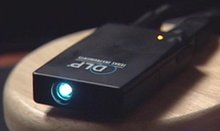Mobile dev platform supports Linux
Feb 18, 2009 — by LinuxDevices Staff — from the LinuxDevices Archive — 4 views Texas Instruments (TI) announced an MDP (mobile development platform) using its OMAP3430 system-on-chip (SoC). Available with a Linux BSP (board support package), the “Zoom OMAP34x-II” includes a 4.1-inch multi-touch display, eight megapixel camera, GPS, HDMI output, and a forthcoming pico projection module, says the company.
Texas Instruments (TI) announced an MDP (mobile development platform) using its OMAP3430 system-on-chip (SoC). Available with a Linux BSP (board support package), the “Zoom OMAP34x-II” includes a 4.1-inch multi-touch display, eight megapixel camera, GPS, HDMI output, and a forthcoming pico projection module, says the company.
(Click here for a larger view of TI's Zoom OMAP34x-II MDP)
Targeting smartphone and MID (mobile Internet device) application developers, the Zoom OMAP34x-II is built around TI's OMAP3430. The SoC runs Linux, Windows Mobile, and Symbian operating systems on an 800MHz ARM Cortex-A8 core.
 OMAP35x SOM-LV (Click for details) |
The Zoom OMAP34x-II was developed by Logic Product Development, which has built previous development kits for TI, including its OMAP35x SOM-LV baseboard and Zoom OMAP35x dev kit, which were targeted at medical device development. The baseboard (pictured) and Zoom kit were based on TI's OMAP35x platform, which was released after the handset-focused OMAP34x, in different models targeting a variety of compact and mobile consumer electronics devices.
The new OMAP34x MDP design includes both a QWERTY keyboard and a 4.1-inch WVGA (800 x 480) touchscreen display. The MDP uses a capacitive touchscreen, which is billed as supporting multi-touch operation. An even more distinctive hardware feature, once it arrives, will be the device's DLP (digital light processing) Pico Projector module (pictured below), which TI says will be available around the middle of this year.
 TI's Pico Projector (Click for details) |
The feature-packed OMAP34x-II uses TI's WL1271, a single chip that provides it with 802.11b/g/n wireless networking, Bluetooth, and an FM transmitter/receiver, according to the company. The device will also be available with a 3G modem, and can support “any third-party modem” via an extension card, the company says.
The OMAP34x-II includes an eight megapixel camera, GPS, and dual accelerometers “for differential detection.” Meanwhile, wired interfaces include HDMI, composite video, audio I/O, and USB, says TI.
In addition, the Zoom MDP has a 200-pin expansion connector, intended for linking the device to an available debug board. Though TI didn't provide a picture of the latter, it said the debug board includes gigabit Ethernet with an RJ45 connector, five USB ports, a UART, and JTAG connectors.
According to TI, the Zoom OMAP34x-II comes with 256MB of low-power DDR memory, and 512MB of NAND flash storage. The device also has a “6-in-1” SD/MMC slot, and is supplied with a 16GB SanDisk eMMC memory card, the company says.
Features and specifications listed by TI for the Zoom OMAP34x-II MDP include:
- Processor — OMAP3430 (clock speed n/s)
- Memory — 256MB of DDR RAM and 512MB of flash storage
- Display — 4.1-inch WVGA (800 x 480) capacitive touchscreen
- Keys — QWERTY keyboard, plus eight function keys and five-way controller
- Wireless:
- WAN — 3G modem (optional)
- WLAN — 802.11b/g/n
- PAN — Bluetooth
- GPS
- FM transceiver
- WAN — 3G modem (optional)
- Other I/O:
- Audio I/O (2.5mm connectors)
- Dual microphone inputs
- Stereo speakers
- HDMI port
- Composite video outout
- Mini USB
- Audio I/O (2.5mm connectors)
- Expansion:
- SD/MMC card slot
- 200-pin expansion connector (debug interface)
- SD/MMC card slot
- Power requirements — n/s
- Dimensions — 140 x 121 x 21mm
According to TI, the OMAP34x-II MDP works with an open-source Linux BSP based on kernel 2.6.11. The device is also being demonstrated at this week's Mobile World Congress with a separately available Windows Mobile 6.5 BSP developed by Bsquare.
This promotional video demonstrates the OMAP34x-II MDP
(click to play)
Source: TI
Availability
The Zoom OMAP34x-II MDP is being demonstrated this week at TIs' MWC stand, Hall 8, #8A84. The device will ship in April for approximately $1,150 without the 3G modem, or $1,400 with it, according to Logic PD and TI.
Further information may be found on the TI website, here, and the Logic PD website, here.
This article was originally published on LinuxDevices.com and has been donated to the open source community by QuinStreet Inc. Please visit LinuxToday.com for up-to-date news and articles about Linux and open source.